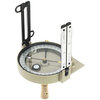That was my take also, however...………...
Hmm, now cedar is an interesting thought. It has the right rigidity for a walking stick, though certainly not the desired strength. And it does tend to grow in clumps, depending on the species, which would account for a root collar of that size on a stem that narrow. It’d make sense for the straightness of the stem also as interior stems in clumpy species tend to be straight. It would also make sense for the limbs. Good thought that.
Or..... maybe not. Don’t know.
My grandfather liked to carve and work with wood. I have all kinds of carved animals and other items he liked to make. Wonderful stuff to remember him by. So he may have made it just for his own enjoyment, or for my grandmother who had mobility issues.
My great grandfather and grandmother on that side of the family came over from Germany on the boat. If it came from Europe, it's likely to remain a mystery. You know, I really should ask my siblings if they remember the story. I rather assumed they wouldn't.
It might be a shoot that sprouted from a stump, and thus the larger knob than what one would otherwise expect. Which would also be a possible explanation for the cavities in the knob. So would your clumping theory.






